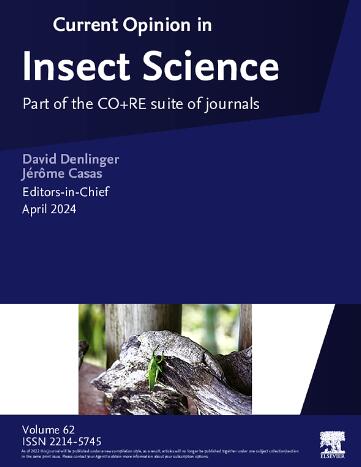昆虫基因调控网络的进化
IF 4.8
1区 农林科学
Q1 BIOLOGY
引用次数: 0
摘要
基因调控网络(GRNs)在性状进化中的变化已被深入研究,昆虫提供了极好的模型案例。在对果蝇、蝴蝶和其他昆虫的研究中,几个众所周知的案例表明,控制性状的基因顺式调控区域的变化可以导致基因的共同选择,其作用与其原始发育环境不同。当一个控制多个下游基因表达的调控基因的表达发生改变时,这些下游基因的表达也会发生相应的变化,这是GRN共选择的最简单形式。许多研究探索了该模型在获得新特征方面的适用性,并产生了实质性的见解。然而,目前还没有研究全面阐明GRN的共同选择或网络结构的进化,包括相关基因及其调控关系。在不久的将来,单细胞多组学和机器学习的使用将允许更大规模的数据分析,从而通过grn的进化更好地理解性状的进化。本文章由计算机程序翻译,如有差异,请以英文原文为准。
Evolution of gene regulatory networks in insects
Changes in gene regulatory networks (GRNs) underlying the evolution of traits have been intensively studied, with insects providing excellent model cases. In studies using Drosophila, butterflies, and other insects, several well-known cases have shown that changes in the cis-regulatory region of a gene controlling a trait can result in the co-option of the gene for a role different from that in its original developmental context. When the expression of a regulatory gene that controls the expression of multiple downstream genes is altered, the expression of these downstream genes changes accordingly, representing the simplest form of GRN co-option. Many studies have explored the applicability of this model to the acquisition of new traits, yielding substantial insights. However, no study has yet comprehensively elucidated the co-option of a GRN or the evolution of a network architecture, including associated genes and their regulatory relationships. In the near future, the use of single-cell multiomics and machine learning will allow for larger-scale data analysis, leading to a better understanding of the evolution of traits through the evolution of GRNs.
求助全文
通过发布文献求助,成功后即可免费获取论文全文。
去求助
来源期刊

Current opinion in insect science
BIOLOGYECOLOGYENTOMOLOGY-ECOLOGY
CiteScore
10.40
自引率
1.90%
发文量
113
期刊介绍:
Current Opinion in Insect Science is a new systematic review journal that aims to provide specialists with a unique and educational platform to keep up–to–date with the expanding volume of information published in the field of Insect Science. As this is such a broad discipline, we have determined themed sections each of which is reviewed once a year.
The following 11 areas are covered by Current Opinion in Insect Science.
-Ecology
-Insect genomics
-Global Change Biology
-Molecular Physiology (Including Immunity)
-Pests and Resistance
-Parasites, Parasitoids and Biological Control
-Behavioural Ecology
-Development and Regulation
-Social Insects
-Neuroscience
-Vectors and Medical and Veterinary Entomology
There is also a section that changes every year to reflect hot topics in the field.
Section Editors, who are major authorities in their area, are appointed by the Editors of the journal. They divide their section into a number of topics, ensuring that the field is comprehensively covered and that all issues of current importance are emphasized. Section Editors commission articles from leading scientists on each topic that they have selected and the commissioned authors write short review articles in which they present recent developments in their subject, emphasizing the aspects that, in their opinion, are most important. In addition, they provide short annotations to the papers that they consider to be most interesting from all those published in their topic over the previous year.
 求助内容:
求助内容: 应助结果提醒方式:
应助结果提醒方式:


